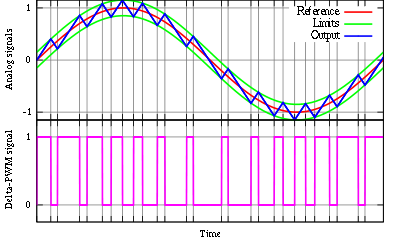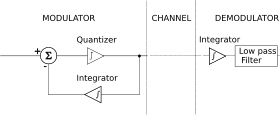- Delta modulation
-
Delta modulation (DM or Δ-modulation)is an analog-to-digital and digital-to-analog signal conversion technique used for transmission of voice information where quality is not of primary importance. DM is the simplest form of differential pulse-code modulation (DPCM) where the difference between successive samples is encoded into n-bit data streams. In delta modulation, the transmitted data is reduced to a 1-bit data stream. Its main features are:
- the analog signal is approximated with a series of segments
- each segment of the approximated signal is compared to the original analog wave to determine the increase or decrease in relative amplitude
- the decision process for establishing the state of successive bits is determined by this comparison
- only the change of information is sent, that is, only an increase or decrease of the signal amplitude from the previous sample is sent whereas a no-change condition causes the modulated signal to remain at the same 0 or 1 state of the previous sample.
To achieve high signal-to-noise ratio, delta modulation must use oversampling techniques, that is, the analog signal is sampled at a rate several times higher than the Nyquist rate.
Derived forms of delta modulation are continuously variable slope delta modulation, delta-sigma modulation, and differential modulation. Differential pulse-code modulation is the super set of DM.
Contents
Principle
Rather than quantizing the absolute value of the input analog waveform, delta modulation quantizes the difference between the current and the previous step, as shown in the block diagram in Fig. 1.
The modulator is made by a quantizer which converts the difference between the input signal and the average of the previous steps. In its simplest form, the quantizer can be realized with a comparator referenced to 0 (two levels quantizer), whose output is 1 or 0 if the input signal is positive or negative. It is also a bit-quantizer as it quantizes only a bit at a time. The demodulator is simply an integrator (like the one in the feedback loop) whose output rises or falls with each 1 or 0 received. The integrator itself constitutes a low-pass filter.
Transfer characteristics
The transfer characteristics of a delta modulated system follows a signum function,as it quantizes only two levels and also one-bit at a time.
The two sources of noise in delta modulation are "slope overload", when steps are too small to track the original waveform, and "granularity", when steps are too large. But a 1971 study shows that slope overload is less objectionable compared to granularity than one might expect based solely on SNR measures.[1]
Output signal power
In delta modulation there is no restriction on the amplitude of the signal waveform, because the number of levels is not fixed. On the other hand, there is a limitation on the slope of the signal waveform which must be observed if slope overload is to be avoided. However, if the signal waveform changes slowly, there is nominally no limit to the signal power which may be transmitted.
Bit-rate
If the communication channel is of limited bandwidth,there is the possibility of interference in either DM or PCM. Hence, 'DM' and 'PCM' operate at same bit-rate.[dubious ]
Adaptive delta modulation
Adaptive delta modulation (ADM) or continuously variable slope delta modulation (CVSD) is a modification of DM in which the step size is not fixed. Rather, when several consecutive bits have the same direction value, the encoder and decoder assume that slope overload is occurring, and the step size becomes progressively larger. Otherwise, the step size becomes gradually smaller over time. ADM reduces slope error,at the expense of increasing quantizing error.This error can be reduced by using a low pass filter.
Comparison of PCM and DM
- Signal-to-noise ratio of DM is larger than signal-to-noise ratio of PCM.
- For an ADM signal-to-noise ratio is comparable to Signal-to-noise ratio of companded PCM.
- In PCM,that it transmits all the bits which are used to code a sample, whereas in DM transmits only one bit for one sample.
- In PCM system Highest Bandwidth is required since the number of bits are high,but in DM system lowest bandwidth is only required.
- PCM system is complex in design when compared to DM system.
- No feedback exists in case of PCM system, but feedback exists in DM system.
Applications
Delta modulation, in particular pure DM has very few practical uses. However it is an interesting concept.
See also
- Adaptive differential pulse-code modulation
- Analog-to-digital converter
- Codec
- Pulse-code modulation
- Pulse-density modulation
Sources
- Steele, R. (1975). Delta Modulation Systems. London: Pentech Press. ISBN 0-4708-2104-3.
 This article incorporates public domain material from the General Services Administration document "Federal Standard 1037C" (in support of MIL-STD-188).
This article incorporates public domain material from the General Services Administration document "Federal Standard 1037C" (in support of MIL-STD-188).
- ^ N. S. Jayant and A. E. Rosenberg. "The Preference of Slope Overload to Granularity in the Delta Modulation of Speech". The Bell System Technical Journal, Volume 50, no. 10, December 1971. [url=http://bstj.bell-labs.com/BSTJ/images/Vol50/bstj50-10-3117.pdf]PDF[/url]; [url=http://webcache.googleusercontent.com/search?q=cache:iKHjaRUY3ssJ:bstj.bell-labs.com/BSTJ/images/Vol50/bstj50-10-3117.pdf+preference+overload&cd=2&hl=en&ct=clnk&gl=us&client=firefox-a]Google cached HTML version</a>)
External links
Categories:
Wikimedia Foundation. 2010.


